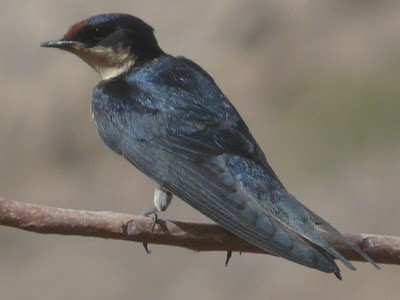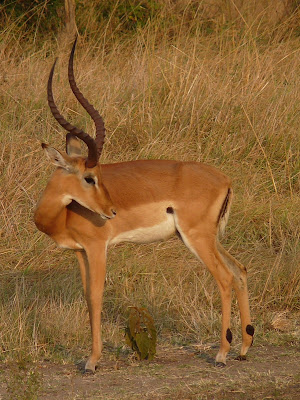A rule of mine when travelling is never to drive past a sewage pond without visiting to see what birds are there. (You'd be astonished how many visitor information centres have no idea where their nearest ponds are!) It's becoming tricky actually, as lawyers increasingly impose themselves and more councils are closing their ponds to public access; really, there's not much other reason to visit some of those places!
Another 'must stop for' is a bird hide. Actually, the two are not necessarily exclusive of each other. In Paarl, north-east of Cape Town, the sewage works are delightfully called the Paarl Bird Sanctuary and come with welcome signs, an information shelter, hides and picnic tables! I was most impressed. Most hides are in wetlands, though not all. In Gluepot Reserve in the South Australian mallee, and at the excellent Arid Lands Botanic Garden in Port Augusta (also South Australia), there are good and productive hides facing small artificial drinking points in dry woodland.
Nor do hides necessarily have to feature birds, though most do.
![]() |
White Rhinos, above, Nyala male below,
Kumasinga Waterhole, Mkuzi Reserve, Zululand, South Africa. |
This superb hide, accessed by a wooden corridor two metres high and at least 200 metres long, overlooks a small pipe-fed pool. Needless to say, birds feature heavily too - a gorgeous Purple-crowned Turaco springs to mind.
Elsewhere in South Africa I recall the impressive Sable Hide in Kruger National Park, where one can rent a fold-down bed for the night. This is an especial treat because in most of Kruger you are forbidden to get out of the vehicle, on pain of instant expulsion from the park. (Or death, depending on whether the rangers get to you before an elephant, lion or buffalo.)
So, what is a hide? Essentially it is just a little room, usually wooden, with slot windows in front and perhaps the sides, and benches to sit on. Ideally the approach will be screened so that birds are not scared off even before you get to the hide.
![]() |
| Cygnus Hide, Kellys Swamp, Jerrabomberra Wetlands, Canberra. The brush fences screen the approaches to the hide from the birds on the water (to the left of the picture). |
Crucially, it has a back wall (or usually a wooden baffle, inside or outside, masking the doorway) so that watchers sitting at the windows are not silhouetted from the front of the hide. Birds are nervous about this, and generally won't come as close. It's a universally recognised requirement, so it's a surprise to find a few hides that overlook this necessity. In Australia, Abattoir Swamp Environmental Park near Julatten in tropical Queensland is one which is notorious for this design flaw (at least it was last time I was there, some years ago now; if it's been rectified I'd be glad to pass on the good news). This hide is also notorious for being bird-poor in a very bird-rich area, though of course I can't say that this is the only reason. New hides near Lake Cargelligo in central western New South Wales were built similarly flawed, though I've heard that there is interest in fixing them.
Embarrassingly and incomprehensibly, the formerly excellent hides at Kellys Swamp, Jerrabomberra Wetlands - Canberra's premier wetlands - have recently been severely compromised by having the internal baffles removed so that the incumbent birders are now clearly silhouetted!
![]() |
| Cygnus Hide, Kellys Swamp, from a bird's eye view. Anyone sitting in the middle of the hide is now clearly outlined against the sky behind. Nor is the problem just from straight in front, as the shot below from off to one side illustrates. |
Additionally, there were extra benches along the internal baffles, so there is now also less seating area. The rationale is a complete mystery. At one stage it was vaguely suggested that some people might be nervous about coming into a dark hide, but I've never met or heard of a birder unwilling to use these hides (though I know of hundreds who do). A direct written question to the board administering the wetland failed to elicit a response, so one must assume that no such survey was ever actually done and that hideophobia is an urban wetland myth.
The little screen to the right of shot in the first picture of the hide above is supposed to overcome this problem but, as the subsequent photos show, it is nowhere near high enough.
My consolation comes from my experience of cycles and corporate memory; one day someone will say "isn't it funny that they never thought to put baffles in those hides?", and they will reappear!
In Peru and Ecuador (and probably elsewhere in South America) there are hides erected at clay licks where parrots come in to collect clay at cliff faces or river banks - apparently primarily as a sodium source, though we can talk more about that another day. Some, such as this one near Amazonia Lodge on the Rio Madre de Dios, are very basic open structures, but backed by a vegetated bank.
![]() |
| Needless to say, the views here as elsewhere are not guaranteed! |
My very favourite bird hide anywhere however is this superb two storey structure which boasts its own toilet! It is run by the Blanquillo Lodge further downstream from Amazonia Lodge.
![]() |
| This is only a section of it. As the parrots move to new sections of the clay bank (visible through the wooden supports below the hide itself) the hide is extended; it is at least a hundred metres long. Note the solid back wall. |
Here are some views from it.
![]() |
| Orange-cheeked Parrots Pyrilia barrabandi and Blue-headed Parrots Pionus menstruus. |
![]() |
| Red and Green Macaws Ara chloropterus, above and below. |
![]() |
| Yellow-crowned Parrots Amazona ochrocephala, Mealy A. farinosa and Blue-headed Parrots. |
![]() |
| Zone-tailed Hawk Buteo albonotatus.This is not the only predator to chance its arm (or wing) at the licks. An entry in the log book for the previous week described how an Ocelot sprang from the foliage and seized a macaw! |
Finally, I must share with you this somewhat sobering sight from Peru. The previous year we had delighted in Andean Cocks-of-the-Rock Rupicola peruvianus displaying from a little rainforest hide by the road. In the intervening February very heavy rains had caused many landslides, including the one that reduced the hide to this.
![]() |
Ruins of Cock-of-the-Rock Hide, San Pedro, Peru, 2010, above and below.
Fortunately it wasn't being used at the time!
When I was last there, the scene below had been dense rainforest. |
However, you shouldn't really be put off using hides by this - most of them never get struck by landslides, thunderbolts or mortar shells!
And there are few if any better places on earth for just contemplating life, in between enjoying the wildlife at close range.




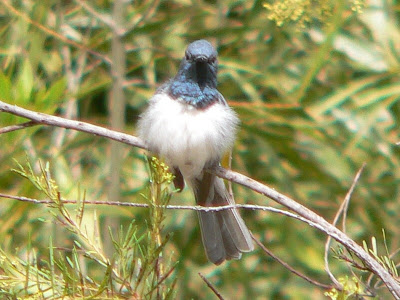

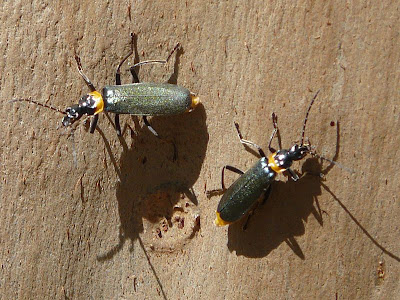













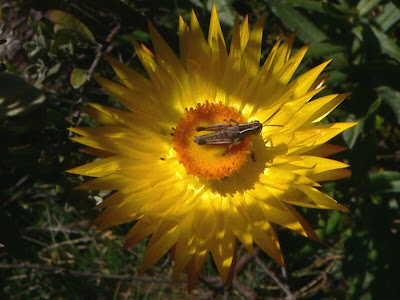










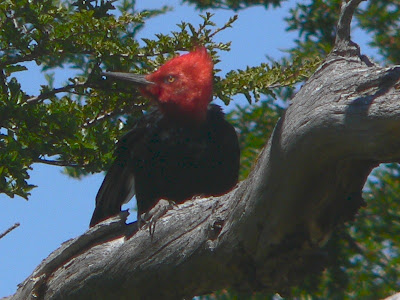




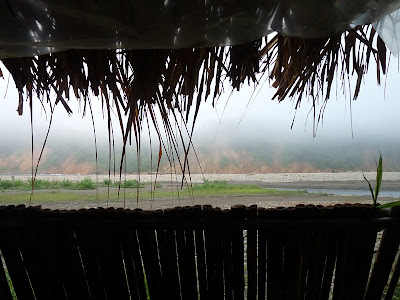





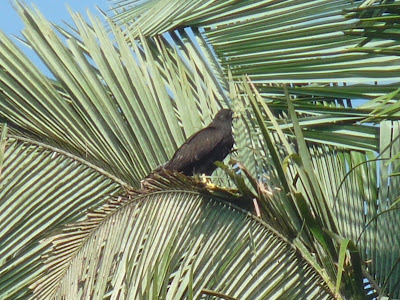
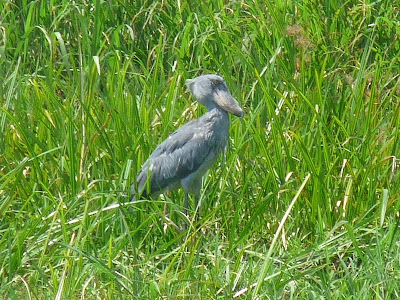









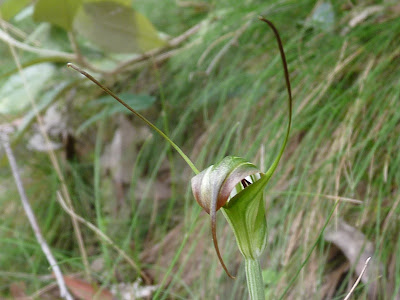+TNR+0310.jpg)

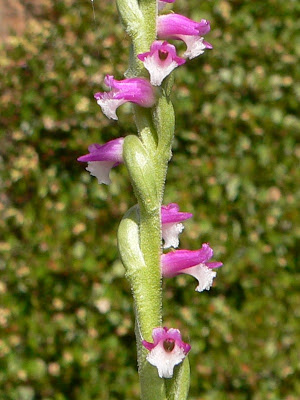
+exiguum+closeup+Bom+Ck+Nowra+0309.jpg)

+TNR+0310.jpg)
+sp+Alligator+Gorge+0807.jpg)
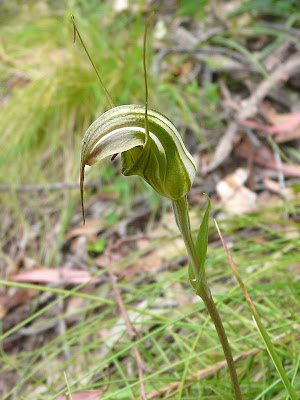




+plumosum+Alligator+Gorge+0807.jpg)















